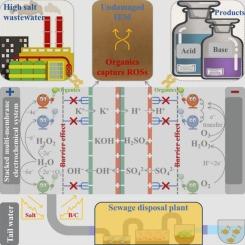叠置多膜电化学系统在高盐度废水中实现盐回收和有机物降解
IF 13.2
1区 工程技术
Q1 ENGINEERING, CHEMICAL
引用次数: 0
摘要
目前用于管理高盐度废水的方法,如蒸发、燃烧和高级氧化工艺,不仅给企业带来了沉重的负担,而且也不符合当前低碳经济的原则。在此,我们开发了一种新型的堆叠多膜电化学系统(SMES),通过同时回收盐分和降解有机污染物,有效地提高了高盐度废水的处理价值。中小企业中多膜的集成不仅提高了盐的回收率,还减轻了有机物的泄漏,而颗粒活性炭珠的添加进一步提高了有机污染物的降解效率。对几种高盐度废水进行了有效处理,验证了sme技术的可扩展性。这些废水中85%以上的无机盐转化为酸和碱,79.63% ~ 99.60%的有机污染物被原位生成的活性氧(ROS)降解,从而降解为小分子。同时,有机污染物还可以作为活性氧的清除剂,为膜提供保护。值得注意的是,与传统的双极膜电渗析相比,SMES表现出更高的能源效率。我们的研究为管理高盐度废水提供了一个有价值的技术解决方案,促进了从传统的能源密集型方法向更可持续的、以回收为重点的方法的转变。本文章由计算机程序翻译,如有差异,请以英文原文为准。


Stacked multi-membrane electrochemical system achieving simultaneous salt recovery and organics degradation in high salinity wastewaters
Current approaches such as evaporation, combustion and advanced oxidation processes for managing high salinity wastewaters not only impose a significant burden on enterprises but also fail to align with the principles of the prevailing low carbon economy. Herein, we developed the novel stacked multi-membrane electrochemical system (SMES) that efficiently increased the value of high salinity wastewater through simultaneously recovering salts and degrading organic pollutants. The integration of multiple membranes in SMES not only enhanced salt recovery but also alleviated organics leakage, while the addition of granular activated carbon beads further augmented the degradation efficiency of organic pollutants. Several high salinity wastewaters were efficiently processed, confirming the scalability of SMES technology. More than 85 % of inorganic salts in these wastewaters converted to acids and bases, and 79.63 %−99.60 % of organic pollutants were degraded by reactive oxygen species (ROS) generated in situ, thereby degrading to small molecules. Simultaneously, the organic pollutants could also serve as scavengers for ROS to provide membrane protection. Notably, the SMES exhibited superior energy efficiency compared with the conventional bipolar membrane electrodialysis. Our study provides a valuable technological solution for managing high salinity wastewaters, facilitating a transition from conventional, energy-intensive methods to a more sustainable, recycling-focused approach.
求助全文
通过发布文献求助,成功后即可免费获取论文全文。
去求助
来源期刊

Chemical Engineering Journal
工程技术-工程:化工
CiteScore
21.70
自引率
9.30%
发文量
6781
审稿时长
2.4 months
期刊介绍:
The Chemical Engineering Journal is an international research journal that invites contributions of original and novel fundamental research. It aims to provide an international platform for presenting original fundamental research, interpretative reviews, and discussions on new developments in chemical engineering. The journal welcomes papers that describe novel theory and its practical application, as well as those that demonstrate the transfer of techniques from other disciplines. It also welcomes reports on carefully conducted experimental work that is soundly interpreted. The main focus of the journal is on original and rigorous research results that have broad significance. The Catalysis section within the Chemical Engineering Journal focuses specifically on Experimental and Theoretical studies in the fields of heterogeneous catalysis, molecular catalysis, and biocatalysis. These studies have industrial impact on various sectors such as chemicals, energy, materials, foods, healthcare, and environmental protection.
 求助内容:
求助内容: 应助结果提醒方式:
应助结果提醒方式:


